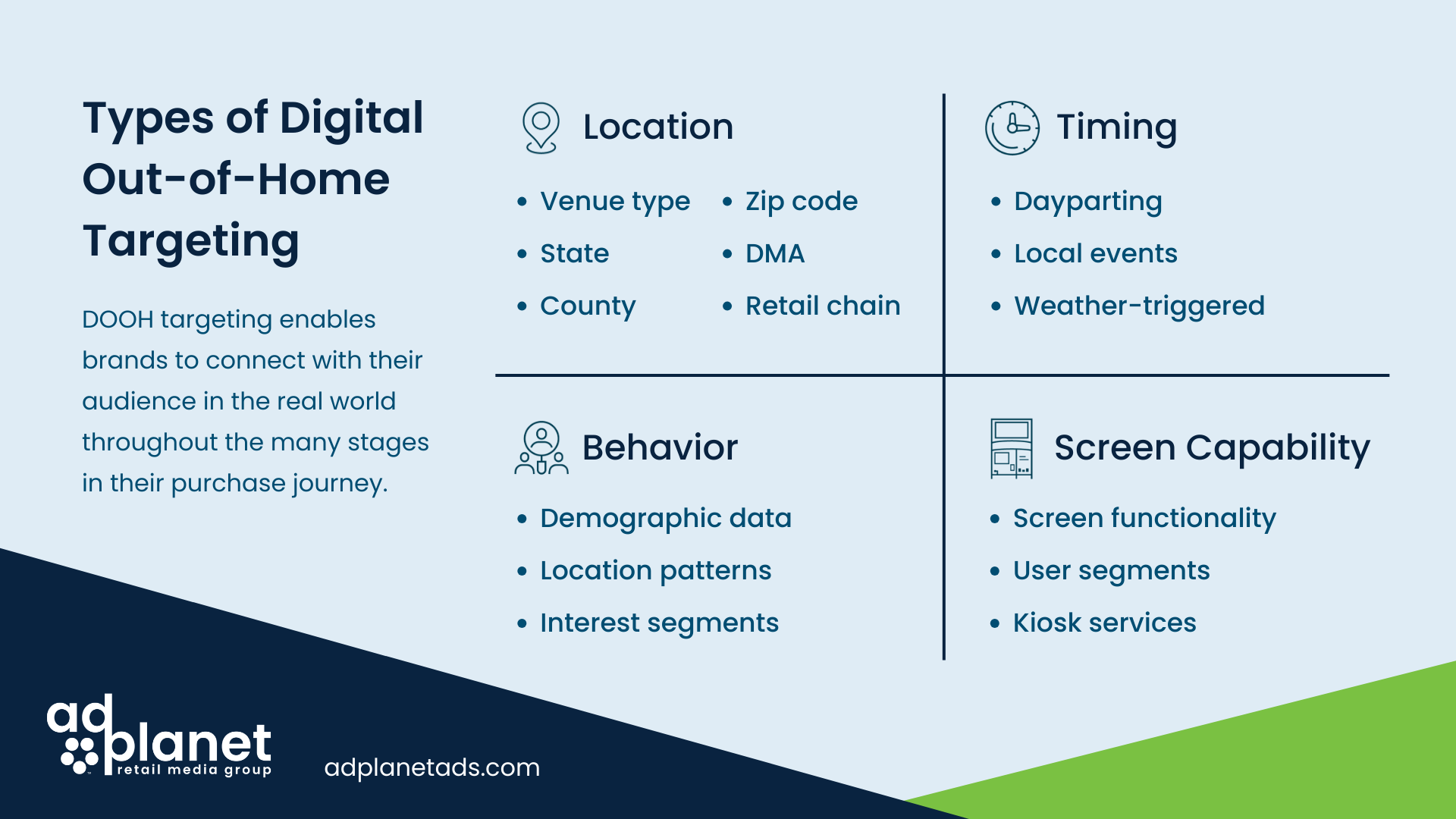
How DOOH Targeting Capabilities Are Surpassing Other Digital Channels in 2024
The ability of advertisers to reach the right people, at the right time, and with the right message is crucial in an ad-saturated world. Targeting capabilities in the digital landscape continue to evolve, especially with the depreciation of third-party cookies already in progress.
As it becomes more difficult to target and retarget consumers online, marketers must adapt and explore other advertising channels to reach their audiences in context.
Digital out-of-home targeting
Digital out-of-home offers a unique opportunity for contextual targeting, allowing advertisers to connect with their audience in the real world throughout the many stages in their purchase journey.
DOOH screens placed in stores, on busy sidewalks, along the roadside, and other locations consumers travel through let brands display their message at the best place and time to influence awareness and behavior. And recent data shows that consumers increasingly prefer DOOH over other mediums. Compared to web ads, consumers view DOOH as 11% more memorable, 10% more entertaining, and 8% more trustworthy.
Along with increased ad relevancy, effective targeting enables brands to minimize wasted ad spend. Marketers can’t afford to overlook DOOH’s targeting capabilities, which span location, timing, consumer behavior, and more.
Targeting & programmatic DOOH
Programmatic DOOH takes targeting a step further by giving advertisers full control over when and how their ads appear. With a self-service demand side platform (DSP), advertisers can even pivot their strategy real-time in response to performance and other factors.
A study conducted by Clear Channel using neuroimaging found an 18% increase in viewer brain response to DOOH ads with contextually relevant content, a 12% increase for ads with relevant timing, and a 32% overall increase in response for ads with contextually relevant content and timing.
The innovative format of digital out-of-home, coupled with its data-driven programmatic features, empowers brands to rise above today’s targeting challenges and engage consumers where and when it matters.

Location based targeting
DOOH lets you target by location in a number of ways. One of the first considerations for any DOOH campaign is what kind of venue you should advertise in.
DOOH networks that fall into the categories of place-based or point-of-purchase media offer valuable placement in locations where purchase decisions are top of mind. For example, adPlanet’s DOOH network includes screens placed inside grocery stores and supermarkets. Venues like this allow brands to target consumers in a more specific context than large format ads like digital billboards.
Other standard location based DOOH targeting options include:
- State
- County
- Zip code
- Designated market area (DMA)
Using these criteria, advertisers can target a few or many areas at one time. As you consider where to run your ads, evaluate which DOOH networks can help you reach your distinct audience and whether you require location targeting outside of these criteria.
adPlanet’s targeting capabilities aren’t limited to the standard zip code and DMA criteria. Because our screens are located in most of the largest grocery stores in the US, advertisers can use more granular targeting by retailer or type of retailer. For example, a brand may want to place ads in high-end grocery venues only or discount grocers only.
Time based targeting
Timing is another critical aspect of DOOH effectiveness – how can you reach potential customers nearest to their moment of decision?
Daypart targeting lets you specify what time of day or which specific hours of the day you want your ad shown. For example, a quick-service restaurant advertiser may want to promote breakfast items in the morning and feature its late-night menu after 10PM.
Just like with location, time-based targeting options vary from one network to the next. adPlanet enables media buyers to hyper-target with its advanced targeting capabilities, such as timing based on weather or local events. Imagine only showing your ad for umbrellas when it’s raining. Not only would you reach people at the precise moment they’re in need of your product, but you’d also spend more efficiently by only showing your ad when most relevant.
Behavioral targeting
Behavioral targeting involves identifying demographic segments based on interests and behaviors, such as places a certain audience tends to visit. DOOH presents unique capabilities for behavioral targeting driven by how consumers move in the real world, not just online. Place-based DOOH can help advertisers connect with a defined audience based on the type of venue the screen is in, what type of screen it is, and more.
Because adPlanet’s screens are located in over 500 retail chains, brands can reach different demographics by choosing certain retailers. And with screens on both the user interface of the kiosk and the 32″ high-definition topper, advertisers can break down those retailer segments further.
For example, some brands may want to reach the demographic who transacts on the kiosks and choose a UI placement. While those wanting to reach the diverse audience of the retailer’s store traffic can build awareness on the topper screen.
Many DOOH networks plug into standardized market segment data to implement behavioral targeting as well. These sources can vary by network and DSP, but one such example is Claritas PRIZM segments, which have helped marketers achieve a 4-6x greater ROI on average. It’s important to evaluate the behavioral targeting options each network offers and determine how they can help you reach your campaign goals.
Targeting by screen capability
Some digital out-of-home screens do more than display ads. Interactive DOOH screens can help advertisers communicate with a targeted group of users depending on the screen’s functionality. Interactive DOOH can be found in places like self-service kiosks, vehicle fuel stations, and other touchscreen signage.
When it comes to campaign targeting, advertisers should think about not just what the screen does but also who is frequently using it or nearby. Targeting by screen capability can be an effective method to target individual interests, needs, and more.
adPlanet’s DOOH screens are placed on Coinstar kiosks, which offer services that can vary from kiosk to kiosk. For example, some Coinstar kiosks offer eGift Cards for stores and brands that other kiosks may not carry. If you’re promoting a product such as gaming computers or accessories, you may want to target kiosks that offer eGift Cards for an online game store.
Beyond the targeting benefits, interactivity can make a DOOH screen more visible and engaging. It reaches people who are actively engaging with the screen. In adPlanet’s case, this includes users with their attention on the screen as they wait to complete a transaction.
Screen capabilities can be an important consideration for your strategy when you have access to DOOH screens that are not only highly visible but functional too.
Context is everything
The range of targeting options you can find when setting up digital out-of-home campaigns can help you reach your audience in ways other channels just can’t achieve. Not all DOOH networks or screens are equal, however. Advertisers benefit when they are able to segment and target their audiences on a granular level, speak to consumers in context, and partner with screen owners who can guide them in their approach.
adPlanet Retail Media Group not only provides unique targeting options to reach every type of retail consumer, but our massive network of 23,000+ screens throughout the US allow you to target and personalize at scale.
Shoppers walk by our screens 1.6x each week on average, unlocking the potential to reach billions of impressions per month and enabling both reach and frequency for advertisers that other DOOH networks struggle to rival. If you want to advertise on the largest retail and grocery DOOH network, reach out to our team of experts to learn more.